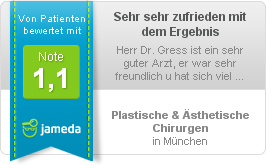
Internationally renowned
Top Specialist
★★★★★
Prof. asoc. Dr. Stefan Gress
Plastic & Aesthetic Surgeon
Lipedema
Lipedema is a pathological, presumably hereditary change in adipose tissue that cannot be treated with diet.


Over 12,500 operations in total
★★★★★
Over 30 years of experience
★★★★★
Scientific Frontrunner



Professor
of Plastic Surgery
Prof. Gress is a member of numerous professional societies.
It goes without saying that Prof. Gress actively participates in the most renowned specialist congresses worldwide and organizes and conducts his own teaching events and lectures, in particular to ensure the highest international standards for surgical and treatment techniques, the »State of the art«.

Everything important at a glance
Lipedema Treatment

Why?
When people experience diet-based weight gain, fat cells enlarge and multiply. Lipedema is the term for a pathological, presumably hereditary change in the fatty tissue that cannot be treated by diet.
The painful increase in fatty tissue affects almost exclusively women and occurs mostly on the hips and legs, less frequently on the arms, stomach or neck.
The most effective treatment method is liposuction of the fatty tissue. A lipedema treatment by liposuction with Prof. Gress in Munich will eliminate or substantially reduce your symptoms, making your body slimmer and more attractive in those problem areas. Most of all, you will feel like you have a new start on life.
Cause
Fat cells absorb more water from the connective tissue, increase in size and, due to the higher pressure, disrupt the lymph flow; this can increase swelling to the extent that it affects the arterial and venous blood supply to the tissue. This increase in tissue fluid is known as edema (hence: lipedema). It leads to hardening (fibrosis) and internal scarring in the subcutaneous fatty tissue, which can be felt as hardened areas under the skin, and it is also painful.
In addition to increased tenderness, there is often a feeling of cold and heaviness in the affected body region.
Treatment
By far the most effective therapy is liposuction (please see details under Liposuction)
With liposuction, a large part of the pathologically altered fat cells are suctioned, the painful pressure on the tissue is eliminated; with a new, aesthetically restored figure, you can let go of the substantial emotional stress you experienced because of your body.
Tightening of the tissue
After a more extensive liposuction procedure, it is possible that the skin does not shrink back and lie smoothly against the body. There can be an excess of skin on the legs, arms and abdomen. This excess must then be removed; otherwise, like an excessively large piece of clothing, it will sag from the body.
Please see more at:
Images
The presentation of before/after pictures on the Internet is prohibited in Germany for aesthetic operations, so we only show pictures of medically indicated treatments here. Please understand that we may only show you pictures during a personal consultation.




Alternative,
non-surgical treatment options
The goal is to decongest the tissue by improving the lymphatic drainage. This can be achieved by means of classic lymph drainage (twice a week) and by wearing special compression undergarments and bandages. Adequate exercise, especially swimming and cycling, is essential, as is a low-salt, alcohol-free diet. Vegetables and fruit should be part of your daily diet. Do not eat after 7:00 pm. Smoking is prohibited.

FAQ / Questions and answers
Is a hospital stay necessary?
Liposuction for lipedema is usually performed in twilight sleep at our clinic in Munich without a hospital stay. Following liposuction, you can rest and recover for a while at the clinic before being picked up. For major liposuction procedures, we recommend one night of inpatient care.
Whether or not an inpatient stay is necessary depends primarily on the expected amount of liposuction: The upper limit of an outpatient liposuction is 4 liters. An inpatient stay is necessary for larger amounts. The upper limit is 6-8 liters per procedure.
Medications
There are no medications that help with lipedema. Diuretics, i.e. dehydrating drugs, must be absolutely avoided, as they further enhance circulation.
Is a health regimen useful?
A health regimen should last for three to four weeks; it can provide slight relief, particularly with regard to tenderness in the tissue. Conservative treatment with a health regimen will not produce a visible change in the shape of the area affected.
Puberty, menopause, hormones?
Development of lipedema is associated with major hormonal fluctuations, such as during puberty and menopause. Other hormonal diseases, such as hypothyroidism, are not proven to cause lipedema.
Bruises (hematomas)?
Pressure on tissue can increase the permeability of small blood vessels, which makes one more prone to bruising.
Which type of liposuction?
There are a number of different methods and devices for liposuction: laser, ultrasound, water jet, etc, and no method has clear advantages over others. Ultimately, it comes down to the skill of the surgeon. What use is a golden chisel to a sculptor if he doesn’t possess the talent to create a beautiful sculpture?
We use a hyperosmolar tumescent infiltration technique. It involves infiltration of the tissue with saline fluid. The slightly higher salt content makes the membranes of the fat cells more permeable, the fat cells lose their structure and are then easier to suction. In addition, the tissue fluid (the edema) reacts to the increased salt concentration (osmosis), which also makes it easier to suction.
How is lipedema diagnosed?
Lipedema begins slowly at first, often on the outside of the thighs (saddlebags), later on the upper and lower legs, and then on the upper body, neck, face, neck or arms. The skin is soft and often appears glassy and transparent. It then takes on a wavy structure and becomes tender. In its later stage, tissue hardening becomes palpable (fibrosis). Symptoms often intensify with heat, prolonged standing and later in the day. Saunas are therefore not recommended.
How long does liposuction for lipedema take and what does it cost?
Depending on the volume of the fatty tissue to be suctioned, treatment takes approximately 30 to 90 minutes, plus preparation time (solution injection and exposure time). If liposuction is performed on several regions of the body in one session, surgery times of 2 to 3 hours or longer may be required. Therefore, costs are highly variable and range between 1500 and 8000 euros depending on the time required.
Added to this are costs for the anesthesia and, if applicable, an inpatient stay.
We would be happy to work out an optional financing plan for you with our partner MEDIPAY in Munich.
Are the costs covered by health insurance?
Because liposuction for lipedema is a medically indicated procedure, your health insurance company should cover the costs. However, you should clarify this in advance. If you request one, we will provide you with a cost estimate during your consultation at our practice, which you can forward to your insurance company. We settle accounts directly with you rather than with health insurance companies. Therefore, you should have advance confirmation that your insurance company will assume the costs. The fee for treatment must be paid before the operation.

Google Rating
★★★★★
From a technical point of view, I have to admit that Doctor Gress works wonders. I had little hope, but he manages to reconstruct everything and I can now feel safe and pain-free.
Google Rating
★★★★★
…I had a vaginal tightening and I must say this man has solved all the problems I had. I no longer have urinary incontinence and everything is perfect! I also had a labia reduction and I can only say: PERFECT! This man really is an artist! …More
Jameda Review
★★★★★
I know that Dr. Gress is a luminary in his field and my very high expectations were met one hundred percent. I can recommend him and his incredibly friendly team without reservation!
Jameda Review
★★★★★
I would like to thank Prof. Gress for his great work. He did such a great job that you can’t believe it. One wonders the whole time how he did it? …More

Well known
from the media

Memberships
Professor Gress is a member in the most important national and international specialist societies.

ASPS
American Society of Plastic Surgeons

DGPRÄC
Deutsche Gesellschaft der Plastischen, Rekonstruktiven und Ästhetischen Chirurgen

ISAPS
International Society of Aesthetic Plastic Surgery

IPRAS
International Confederation for Plastic, Reconstructive and Aesthetic Surgery

Inquire now
A personal conversation provides clarity most quickly. Our communication will be treated professionally and discreetly!













